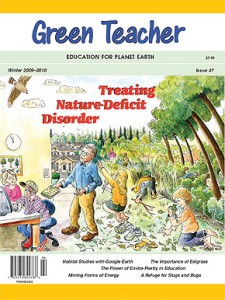Green Teacher 87, Winter 2009-2010
Purchase this issue or subscribe
Features
Last Child in the Woods, First Book in the Field by Mike Weilbacher
A critical appraisal of the enormous impact of Richard Louv’s 2005 book Last Child in the Woods: Saving our Children from Nature-Deficit Disorder. In researching the article, Mike Weilbacher interviewed a great many educators inside and outside the growing child-and-nature movement that was spawned by Louv’s book. The result is an encouraging assessment of the book’s impact on both education and popular culture.
Analyzing Wildlife Habitat with Google Earth by Dawn Tanner
Three classroom lessons for Grades 5-6 that use this free and readily available remote-sensing software can help students learn to recognize the characteristics of good wildlife habitat, monitor changes in land use over time and develop a big-picture understanding of the need for effective conservation strategies
Poetry Power: Using Poems in Environmental Education by Alison Flensburg
Writing poems about environmental themes immerses students in a creative process that engages both our intellect and our emotions, thus strengthening learning and deepening commitment to learn. This article provides guidelines for students writing environmental poems, including where to find example poems for inspiration (examples are provided), and tips for publishing students’ poems.
For Slugs’ Sake: Making a Refuge for Slugs, Bugs and Other Invertebrates by Angela Wilbers Luekenotto and Janice Schnake Greene
A middle school learning exercise (adaptable for elementary and high school), in which students learn about the characteristics and habitat requirements of invertebrates, the most abundant and diverse group of animals on Earth, who serve a major role in recycling nutrients by decomposing organic material.
Key Terms in Environmental Fields: Establishing a Foundation by Fletcher Brown
An activity that helps high school students correct the misconceptions associated with key terms from environmental science and related fields. The activity engages, identifies and clarifies students’ understanding of basic definitions of these terms.
From Seals to Snails: Understanding Eelgrass by Nora Beem, Michael Dufilho and Frederick Short
Provides background information and activities for grades 5-8 on the protective role of the marine plant eelgrass, the complexities involved in cleaning up polluted watersheds, the effects of environmental stressors on eelgrass function, and the impact of declining eelgrass populations on fish.
The Hawk in the Nest by Edith Pucci Couchman
A circle game similar to “The Farmer in the Dell”, which teaches children up to age eight about food chains within a given habitat. Builds students’ understanding of how energy is transferred through various creatures within a community.
Acting Out Energy Forms by Arianna Alexsandra Grindrod (Free article)
A very active activity for grades K-8 which teaches about different forms of kinetic, potential, and renewable energy. Helps provide a context for teaching scientific principles related to energy transformations, chemical transformations, electricity and light, which are central to many clean energy technologies.
Educational Resources Reviewed
Linking Architecture and Education: Sustainable Design for Learning Environments (Anne Taylor)
EcoTipping Points website
Big Ideas (The Center for Ecoliteracy)
The Man Who Planted Trees (Jean Giorno)
How to Turn Your Parents Green (James Russell)
Arctic Mission (National Film Board of Canada)
As If The Earth Matters (Thom Henley and Kenny Peavy)
The Whale Game (Environmental Education Games)
Eagle Eye: A Life and Death Tale of Ecological Intrigue (Peter Donaldson)
Exceptional Women Environmentalists (Frances Mooney)
Beauty Muse: Painting in Communion with Nature (Lisa Lipsett)
Childhood and Nature: Design Principles for Educators (David Sobel)
Toxic Trespass (National Film Board of Canada & If You Love Our Children Productions)
Nature Writing Field Guide for Teachers (Jan Wellik)
Rainwater Harvesting for Drylands and Beyond – Volume 1: Guiding Principles to Welcome Rain into Your Life and Landscape (Brad Lancaster)
Where Do The Children Play? (Michigan Television)
Mapping Our World Using GIS (ESRI Press)
A Sense of Wonder (Sense of Wonder Productions)
Pippa’s First Summer (Catherine Badgley)
Hands-on Herpetology: Exploring Ecology and Conservation (Rebecca Schneider, Marianne Krasny & Stephen Morreale)
Amazing Animal Adventures Around the World (Brian Keating)
Wetlands and the World (Ducks Unlimited Canada)
Green’s Not Black & White: The Balanced Guide to Making Eco Decisions (Dominic Murin)
Beginner’s Guide to Community-Based Arts (Keith Knight & Mat Schwarzman)
Earth Matters (Population Connection)
Leave a Reply
You must be logged in to post a comment.






